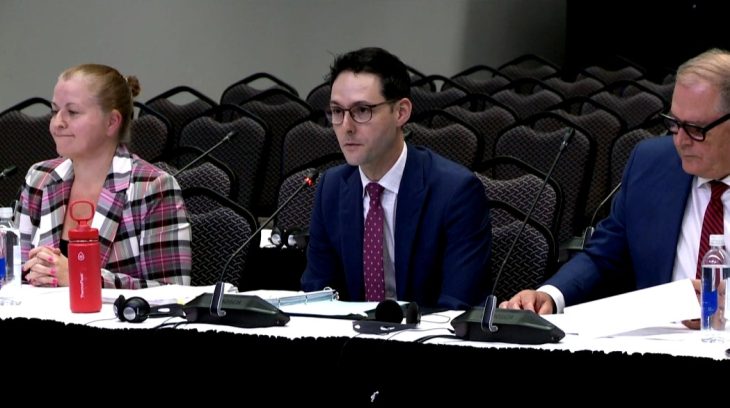
Spoken word on FM, removal of tangible benefits among other recommendations
By Ahmad Hathout
Canadian content quotas on radio have contributed to a competitive imbalance in the market and reducing them will help traditional broadcasters be more adaptable to listener habits, the CRTC heard this week.
Rogers pitched Friday a reduction in the Canadian content quota on English-language radio – from 35 per cent to 25 per cent – that the broadcasting giant said will not only allow it to better manage its operations but also increase the consumption of its products. The company’s director of programming said there’s data to back this claim.
Adam Thompson pointed to a specific section of the CRTC’s 2022 revised commercial radio policy in which the regulator removed the “hits” policy in Ottawa and Montreal. That policy required that less than 50 per cent of all musical selections aired during the broadcasting week be hits, or top songs – an effort to protect the French-language radio stations in bilingual markets. Rogers, Corus, and Stingray asked the commission to abolish that policy at the time.
That decision, according to Thompson, has yielded empirical evidence that eliminating or reducing certain regulatory requirements can bring about positive results.
“In 2023, national tuning fell seven per cent, with the exception of Ottawa and Montreal – both markets grew between two and two-and-a-half per cent,” claims Thompson following the elimination of the hits policy. “So while it’s tough to talk about what’s the direct benefit here, there’s a clear example of allowing programmers more flexibility in what they’re doing will increase the amount of people consuming your products.”
Rogers said the reduction in the quota would still ensure Canadian content levels are “more than twice” what is consumed on digital platforms, which don’t suffer from restrictions like having a finite number of hours and minutes.
“It restricts our ability to program the station and remain agile with our listener’s changing needs,” Susan Wheeler, Rogers’s vice president of regulatory, said about the high quota. “We’re not saying that we won’t play Canadian music and that we don’t want to play Canadian music, we do … we just think that the level needs to be adjusted to allow us to use those finite hours or minutes in the day to have more flexibility to respond to the change in consumer tastes in the different formats that we offer.”
Along those lines, Rogers is urging the commission to utilize incentives, rather than quotas, to encourage the airplay of categories of music like indigenous and emerging artists in any new policy.
The cable giant is just one of several companies and organizations that have called for that 10 per cent reduction in CanCon on radio.
Corus representatives appeared Thursday to also request the same reduction in the quota, claiming it would allow them to do their jobs better.
“We don’t think this would drive significant changes in the way we program or format our stations,” Matt Thompson, vice president and associate general counsel at Corus, said Thursday. “I think our expectation is that it would allow us to do what we’re trying to do better.”
“The current quota has contributed to the situation that radio finds itself in,” Thompson added, noting it isn’t the only cause. “We believe our day-to-day lived experience is such that it is contributing to a competitive imbalance in the market.”
Last week, Stingray Radio, which asked for the same quota target, said forcing Canadians to listen to domestic music because radio operators have to play them will push them toward streaming services. Thompson said Thursday that overplaying is a product of these onerous regulatory burdens.
Corus is also asking the CRTC to eliminate restrictions on the ability of a radio programmers to operate a news talk format on FM frequencies. Thompson illustrated the trouble with AM frequencies by pointing to the fact that electric vehicles are leaving the lot without that functionality. “The regulations are literally preventing distribution of those news talk stations that are already in the market,” he said.
Rogers agrees. It is asking for the CRTC to eliminate the requirement for licensees to obtain approval to operate spoken word formats on FM.
“These rules prohibit AM news and information content from being broadcast on a more reliable and accessible FM signal in the same market,” Rogers said. “This creates a major barrier to distributing highly relevant content to Canadians at a critical time when younger listeners are not developing AM tuning habits and vehicle manufacturers are removing AM receivers from new cars.”
Among other recommendations, Rogers is also asking the CRTC to abolish the tangible benefits policy that forces broadcasters buying other broadcasters to pay into Canadian content funds as a condition of those deals.
Collette Watson, president of Rogers Sports and Media, used the example of American podcasting giant Wondery growing in scale by freely buying up podcasts and serving them to Canadian audiences as another form of regulatory asymmetry.
“Right now we have this barrier of tangible benefits,” Watson said, “whereas they’re going out and just acquiring audio content without such barriers.”
Screenshot of Corus (Matt Thompson in middle) on Thursday



